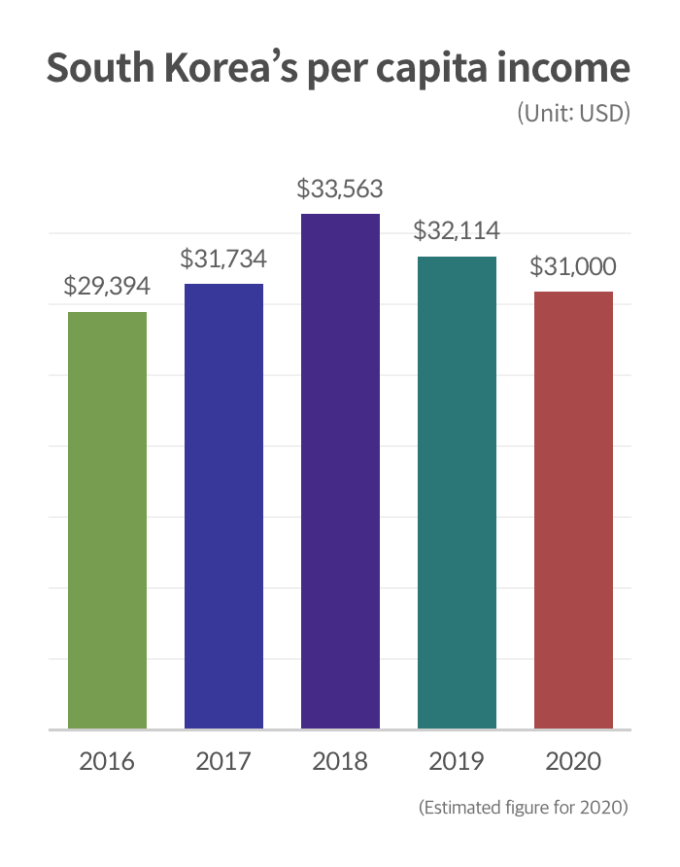Strong KRW helps S. Korea hold above $30,000 per capita GNI
By Nov 03, 2020 (Gmt+09:00)
LG Chem to sell water filter business to Glenwood PE for $692 million


Kyobo Life poised to buy Japan’s SBI Group-owned savings bank


KT&G eyes overseas M&A after rejecting activist fund's offer


StockX in merger talks with Naver’s online reseller Kream


Mirae Asset to be named Korea Post’s core real estate fund operator


The country's gross national income (GNI) per capita this year is expected to be around $31,000, down 3.4%, or $1,114 from last year, according to the sources on Nov. 3.
In 1953, Korea was one of the least developed countries in the world, with an average annual income of $66, following the 1950-53 Korean War. The country entered the $30,000-per-capita income era in 2017 with $31,734 and continued on a two-year growth trend, posting an average income of $33,563 in 2018. Things took a turn in 2019, however, with GNI per capita dropping by 4.3% to $32,114, and the number is expected to drop further this year.

This is the first time for the country's per capita GNI to drop for two straight years since the global financial crisis hit the GNI in 2008 and 2009. The sluggish figures could be owing to the country’s negative economic growth rate, the GDP deflator that measures price inflation, and the value of the Korean won.
The Bank of Korea expects the South Korean economy to shrink by 1.3% in 2020. The GDP deflator, or nominal GDP divided by inflation-adjusted GDP, was 0.3% in the first half of this year. These variables point to a likely 1% drop in the country's average income compared to last year.
Further, a year-to-date drop in the Korean won has weighed on the GNI. The won averaged 1,195.34 to the dollar between January and October of this year, marking a 2.5% depreciation from last year's 1,166 average.
There were views that the country's GNI per capita may fall below $30,000 due to the COVID-19 impact. But with the won staging a recovery since September, economists expect the GNI to remain between $30,000 and $31,000.
The dollar/won exchange rate has held around the 1,130 level since climbing to 1,190 on Sept. 4. This was off this year's high of 1,285 touched on Mar. 19.
Economists expect the dollar/won rate to remain in the 1,110 to 1,150 range through the remainder of this year, keeping the country's GNI per capita above $30,000.
Write to Ik-hwan Kim at lovepen@hankyung.com
Danbee Lee edited this article.
-
 Shipping & ShipbuildingHanwha Ocean shares sink after KDB's sale of 4.2% stake
Shipping & ShipbuildingHanwha Ocean shares sink after KDB's sale of 4.2% stakeApr 29, 2025 (Gmt+09:00)
-
 EnergySouth Korea nears Czech nuclear deal; Doosan, related stocks fly high
EnergySouth Korea nears Czech nuclear deal; Doosan, related stocks fly highApr 25, 2025 (Gmt+09:00)
-

-
 Business & PoliticsSeoul, Washington agree on July tariff deal framework in '2+2' trade talks
Business & PoliticsSeoul, Washington agree on July tariff deal framework in '2+2' trade talksApr 25, 2025 (Gmt+09:00)
-



